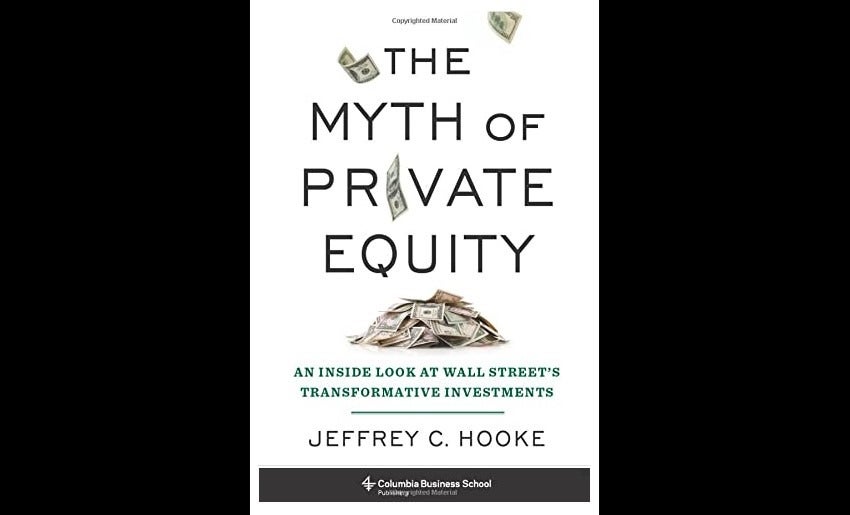
Jeffrey C Hooke’s new book, ‘The Myth of Private Equity: An Inside Look at Wall Street’s Transformative Investments’ is an authoritative assessment of the private equity world deftly exposes its shortcomings, writes Christopher Silvester
The clue is in the title. Jeffrey C Hooke, a professor of finance at Johns Hopkins Carey Business School, is an arch-sceptic when it comes to the private equity industry. He believes that 65 per cent of it – the part which funds leveraged buyouts (LBOs) – is one giant racket, and that its claim to produce better returns than the stock market is bogus. ‘Indeed,’ he writes, ‘independent academic studies show that since 2006, private equity funds underperformed relevant public indices, a fact that is easily eclipsed by the Wall Street marketing machine.’
The first LBO to gain the attention of the media was that for greetings card manufacturer Gibson Greetings in 1983. In the next five years, until the infamous LBO of RJR Nabisco by Kohlberg Kravis Roberts & Co, America experienced its first buyout boom, ‘an underpinning for the 1980s culture of greed’.
Given that most private equity (PE) funds were LBO blind pools, they were inherently risky, in addition to which they were loaded with debt. They also required investors to commit funds for ten years as part of a no-cut contract and pay vast fees regardless of the outcome. But the rise of modern portfolio theory (MPT) meant institutional investors were encouraged to hold a ‘core’ portfolio of traditional assets, such as publicly traded stocks and bonds, and ‘satellite’ portfolios of alternative assets, such as PE and hedge funds.
The LBO boom stalled in the early 1990s after some notable failures but returned with a vengeance in the mid-1990s, with Wall Street having rebranded ‘debt-laden takeover into private equity, a term that conveys a softer image and a more constructive tone than leveraged buyout’. When the stock market fell back after the dotcom boom and bust, institutional investors turned to PE funds as a form of downside protection. There was a 500 per cent increase in deal volume between 2002 and 2007, another fallback during the 2008-09 global financial crisis, and then another long rally despite prominent PE deals ending in bankruptcy.
Today there are 700 LBO fund groups, some focused on deal size, some with an industry focus. They control more than 7,000 companies and employ millions of people. The overall amount of equity invested is around $1 trillion. ‘Private equity is a great thing for America,’ said Stephen Pagliuca, co-chairman of LBO group Bain Capital, in January 2020.
But what is not understood, says Hooke, is ‘the chasm between the vast wealth accrued by PE managers (sometimes called general partners) through management fees and moderate returns provided to LBO fund investors (called limited partners)’. This subject is ‘considered off-limits in the industry and one that outside critics have an uphill battle in publicizing’.
A crucial myth is that of top-quartile performance being repeated in a company’s subsequent funds. Also, fund managers claim to be aligned with investors because they commit 5 per cent of the total of a fund from their own capital, but then they receive 15 per cent in guaranteed management fees, monitoring fees and transaction fees over a ten-year period regardless of how the fund performs.
Hooke cites several studies which have shown that only in the 1990s, ‘the industry’s golden years’, did PE outperform the stock market. ‘In other words, depending on the years chosen, the foundation for a trillion-dollar industry’s marketing fanfare rests on the narrow shoulders of a ten- to 12-year performance span, which is now over 15 years old, or several lifetimes in financial circles… If one adds the requisite 3 per cent premium, as recommended by many experts, for the PE investor’s inability to sell, the LBO industry’s justification for existing is tenuous indeed.’
How do these racketeers get away with it? Roughly 56 per cent of deals bought by PE funds since 2006 have not been sold on and are booked as unsold portfolio gains. What’s more, 40 per cent of PE funds are non-reporting. Hooke points out that Bernie Madoff ’s ‘claimed returns were very favourable compared to benchmarks, but no third party verified the returns for many years’.
The PE industry smooths its returns compared to the stock market, thus making it appear less risky, and PE funds are valued by the Big Four accounting firms in such a way that during market downturns they appear to fall in value less than public companies. As Hooke argues, this ‘flies in the face of financial theory and defies common sense’.
Apart from the racketeers themselves, the PE industry has what Hooke calls its enablers and fellow travellers. The enablers include state legislatures and union leaders, the accounting authorities, the private equity databases, the IRS, and the SEC. For example, the IRS allows PE companies to have a 100 per cent interest expense deduction on their debt loads. The fellow travellers include the business media, investment managers, wealth managers, and even business schools. The business school to which Hooke is affiliated does not have a PE course and yet ‘about half of the students want to join the industry upon graduation’ because they ‘see it as an interesting business and a one-way ticket to a good living’.
This is an excellent, concise book by a veteran industry observer, lucidly and dispassionately written, with abstruse matters explained in layperson’s terms. Hooke realises that he is a Cassandra and that probably nothing will come of his dire warnings. Even mortgage-backed securities and dotcom investments were publicly traded and eventually exposed as investment fads, whereas ‘the rates of return, fees, and diversification attributes of the buyout asset class are shrouded in a numbers fog’. This 40-year-old racket will doubtless continue.
‘The Myth of Private Equity: An Inside Look at Wall Street’s Transformative Investments’ by Jeffrey C Hooke is out on November 15, 2021.
Image: Amazon







